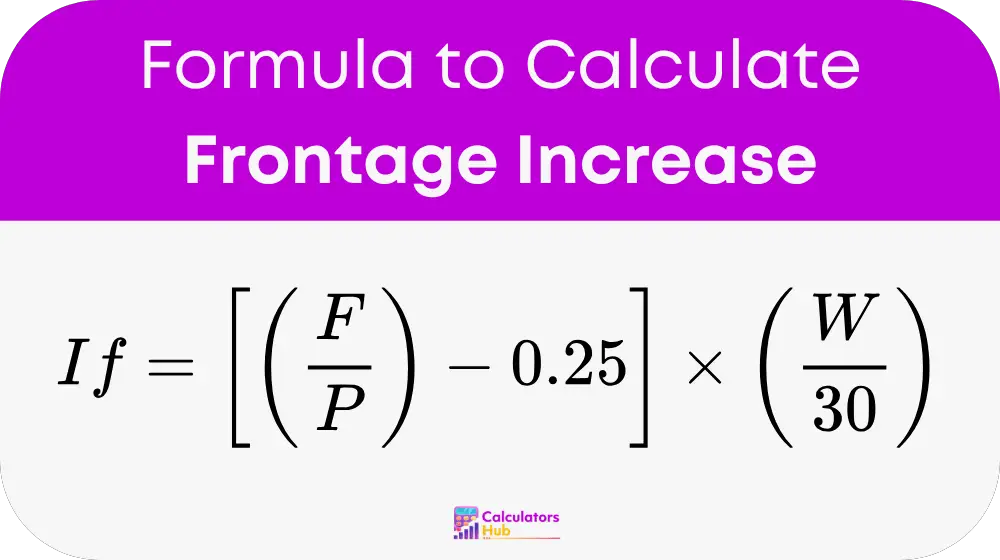A Frontage Increase Calculator is a specialized tool for architects, engineers, and building code officials that determines the allowable increase in a building’s area based on its proximity to open spaces like streets or public ways. According to the International Building Code (IBC), a building with significant open space around it is considered safer in the event of a fire, as it provides better access for firefighters and less risk of fire spreading to adjacent structures. This calculator applies the specific formula from the IBC to quantify how much a building’s basic allowable area can be increased due to this “frontage.” Consequently, it is a critical tool in the early stages of building design to legally and safely maximize the size of a new construction project.
formula of Frontage Increase Calculator
The formula to calculate the allowable frontage increase is provided directly by the International Building Code (IBC).

Where:
- If: The frontage increase factor. This is the result, a decimal value that represents the percentage of increase allowed.
- F: The length of the building perimeter that fronts on a public way or open space, measured in feet.
- P: The total perimeter of the entire building, measured in feet.
- W: The width of the open space in front of the building, measured in feet.
- 0.25 and 30: These are constants given in the building code.
Interpreting the Frontage Increase Variables
The value of ‘W’ in the formula is not always a single number. This table clarifies how to determine the weighted average width ‘W’ when a building has frontage on multiple open spaces of different widths.
| Frontage Scenario | How to Calculate ‘W’ |
| Frontage on one side | W = Width of the single open space (e.g., the street). |
| Frontage on multiple sides with different widths | W = (L₁W₁ + L₂W₂ + … + LₙWₙ) / (L₁ + L₂ + … + Lₙ) |
| (Where L₁ is the length of frontage on a space with width W₁, etc.) | |
| Minimum and Maximum W | The value of ‘W’ used in the formula must be at least 20 feet and is capped at 30 feet. |
Example of Frontage Increase Calculator
An architect is designing a new rectangular commercial building.
First, they gather the building and site dimensions.
- Building Dimensions: 150 feet long by 100 feet wide.
- Frontage: The 150-foot-long side of the building fronts a street.
- Open Space Width: The street and sidewalk provide an open space of 40 feet.
Step 1: Calculate the total building perimeter (P).
P = 2 * (Length + Width)
P = 2 * (150 + 100) = 2 * 250 = 500 feet
Step 2: Identify the frontage length (F).
The building has frontage along one of its 150-foot sides.
F = 150 feet
Step 3: Determine the value of W to use in the formula.
The actual width of the open space is 40 feet. However, the IBC caps the value of ‘W’ used in the calculation at 30 feet.
W = 30 feet
Step 4: Apply the frontage increase formula.
If = [ (150 / 500) – 0.25 ] * (30 / 30)
If = [ 0.3 – 0.25 ] * 1 = 0.05
To express this as a percentage, we multiply by 100.
Increase = 0.05 * 100 = 5%
Therefore, the building’s basic allowable area can be increased by 5% due to its frontage on the public street.
Most Common FAQs
In general, frontage is the side of a building that adjoins or faces a public way (like a street or sidewalk) or a dedicated open space that is permanently accessible, such as a yard or court. The open space must have a minimum width, typically 20 feet, to qualify. The specific requirements can be found in your local building code or the International Building Code (IBC).
The maximum increase allowed for frontage is 75%. This occurs when the building has frontage on all sides (F/P = 1) and the open space width (W) is 30 feet or more. The calculation would be [ (1) – 0.25 ] * (30 / 30) = 0.75, or 75%.
Yes. The frontage increase is calculated separately from the allowable area increase for having an automatic sprinkler system. In many cases, these two increases can be added together to significantly expand the total permitted building area, allowing for larger and more economically viable construction projects. Always consult the specific provisions of the applicable building code to confirm how these increases are combined.